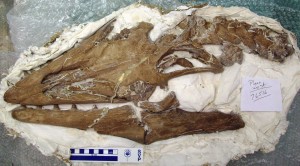
After a bit of a hiatus, work has resumed on the Plano West Mosasaur fossil. In 2009, the fossil, a marine reptile from the Cretaceous period, was discovered buried beneath the creek just in front of the Student Activities Center. Currently being worked on by Bill Johnson, a fossil preparator at the fossil repository in SMU’s Museum of Paleontology, the majority of the restoration consists of removing the limestone matrix (rock surrounding the bone).
“This work is extremely time-consuming, and mind numbingly painstaking,” biology teacher Wesley Kirpach said.
Johnson is using an air abrasive technique which uses a jet of small sand particles to remove the Austin Chalk limestone from the head of the mosasaur in very small increments. The entire skull has been cleaned, and Johnson has recently uncovered the sclerotic rings of both eyes, which are made of bone and support the eyeball from the inside. These rings, which mammals lack but can be found in most other vertebrates, are rarely preserved in fossil remains. Many students, especially those that attended Renner at the time, remember when the fossil was first unearthed back in April of 2009.
“I heard about it when I was in eighth grade and our science teacher took us out to the dried creek where it was found,” senior Kyle Bratton said. “I guess you could say it’s one of the many great things Plano West is home to.”
Others who might not have lived here at the time or do not recall the event are just now being introduced to the mosasaur for the first time.
“I did not know about the discovery back in 2009,” junior Yoko Cavalcanti-Eskai said. “I feel proud of the city of Plano, though. Who knew a place like this could have contained dinosaurs?”
Kirpach confidently believes that this discovery and its exhibition in the near future will help to spark more interest about the giant beasts that roamed the planet so long ago.
“The preservation of the Plano West mosasaur is excellent,” Kirpach said. “These bones will aid greatly in discovering more about the biology and natural history of the creature that once swam above Plano West almost 85 million years ago.”









